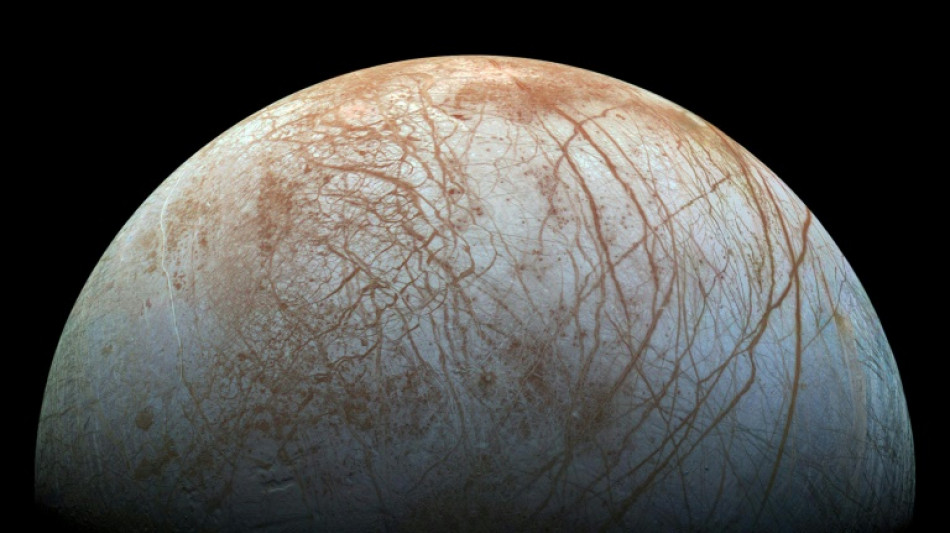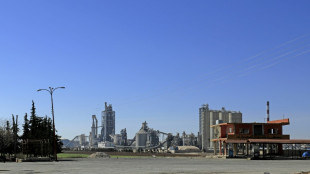
-
 EU scrambles to seal climate deal ahead of COP30
EU scrambles to seal climate deal ahead of COP30
-
New Yorkers expected to pick leftist Mamdani in stunning election

-
 Pining for Pinochet: how crime fanned nostalgia for Chile's dictator
Pining for Pinochet: how crime fanned nostalgia for Chile's dictator
-
Why an Amazon chef said no to a vegan dinner for Prince William event

-
 Cement maker Lafarge on trial in France on charges of funding jihadists
Cement maker Lafarge on trial in France on charges of funding jihadists
-
Worker dies after medieval tower partly collapses in Rome

-
 Run-machine Labuschagne in form of his life ahead of Ashes
Run-machine Labuschagne in form of his life ahead of Ashes
-
Prince William plays football, volleyball in Rio on climate trip

-
 Jamaicans mobilize aid in aftermath of Melissa's wreckage
Jamaicans mobilize aid in aftermath of Melissa's wreckage
-
Starbucks cedes China control to Boyu Capital

-
 Worker rescued after medieval tower partly collapses in Rome
Worker rescued after medieval tower partly collapses in Rome
-
'Wild at Heart' actress Diane Ladd dies at 89

-
 Xhaka lifts Sunderland into fourth after Everton draw
Xhaka lifts Sunderland into fourth after Everton draw
-
Brazil records biggest annual fall in emissions in 15 years: report

-
 Victor Conte, mastermind of BALCO doping scandal, dead at 75: company
Victor Conte, mastermind of BALCO doping scandal, dead at 75: company
-
Trial opens in 1st US civil case on 2019 Boeing MAX crash

-
 Mixed day for global stocks as market digests latest AI deals
Mixed day for global stocks as market digests latest AI deals
-
Barrett brothers out of All Blacks' clash with Scotland

-
 Medieval tower partially collapses in Rome, trapping worker
Medieval tower partially collapses in Rome, trapping worker
-
Arsenal's Arteta says injured Gyokeres out of Slavia Prague tie

-
 Alonso says 'quality' Wirtz helped get him Real Madrid job
Alonso says 'quality' Wirtz helped get him Real Madrid job
-
US Fed's Cook warns inflation to stay 'elevated' next year

-
 Blue heaven: huge crowds salute Los Angeles Dodgers in victory parade
Blue heaven: huge crowds salute Los Angeles Dodgers in victory parade
-
Dutch centrist Jetten clinches election win: final tally

-
 Mamdani extends olive branch to anxious NY business community
Mamdani extends olive branch to anxious NY business community
-
Sierra Leone chimpanzee sanctuary reopens after deforestation protest

-
 Shein bans sex dolls after France outrage over 'childlike' ones
Shein bans sex dolls after France outrage over 'childlike' ones
-
England full-back Steward doubtful for Autumn rugby clash with Fiji

-
 Bayern know how to 'hurt' PSG, says Neuer
Bayern know how to 'hurt' PSG, says Neuer
-
Rybakina downs Swiatek to reach WTA Finals last four

-
 Ex-France international Ben Yedder to stand trial on rape charges
Ex-France international Ben Yedder to stand trial on rape charges
-
Djokovic confirmed for ATP Finals, says Italian federation boss

-
 Trent should be remembered for 'great' Liverpool moments, says Slot
Trent should be remembered for 'great' Liverpool moments, says Slot
-
Stock markets diverge despite boost from AI deals

-
 Prince William awed by Rio on climate-focused trip to Brazil
Prince William awed by Rio on climate-focused trip to Brazil
-
Violence in Sudan's El-Fasher could be war crimes, says top court

-
 Rybakina downs Swiatek in WTA Finals
Rybakina downs Swiatek in WTA Finals
-
Turkey, Muslim allies say Palestinian self-rule key to Gaza future

-
 Tens of thousands shelter as typhoon slams into Philippines
Tens of thousands shelter as typhoon slams into Philippines
-
Stock markets rise as tech sector buoyed by fresh AI deal

-
 Vitinha says PSG-Bayern Champions League clash will show who's 'best'
Vitinha says PSG-Bayern Champions League clash will show who's 'best'
-
Arsenal: The unstoppable Premier League force?

-
 Denmark inaugurates rare low-carbon hydrogen plant
Denmark inaugurates rare low-carbon hydrogen plant
-
Springboks back Ntlabakanye call-up despite doping probe

-
 German plans to lower industrial power costs from January
German plans to lower industrial power costs from January
-
Christian, Muslim Nigerians push back on threatened US strikes

-
 Nigeria's Rivers United paired with African champions Pyramids
Nigeria's Rivers United paired with African champions Pyramids
-
India women cricketers hail new era but challenges remain

-
 'Heroic' worker praised as man charged over UK train stabbings
'Heroic' worker praised as man charged over UK train stabbings
-
Bangladesh ex-PM Zia to contest elections: party

| RBGPF | -3.95% | 76 | $ | |
| CMSD | -0.38% | 23.9 | $ | |
| RYCEF | 1.37% | 15.36 | $ | |
| AZN | -0.83% | 81.72 | $ | |
| SCS | -0.76% | 15.84 | $ | |
| GSK | -1.1% | 46.35 | $ | |
| VOD | -5.89% | 11.38 | $ | |
| RELX | -0.16% | 44.17 | $ | |
| RIO | -1.95% | 70.37 | $ | |
| CMSC | -0.34% | 23.67 | $ | |
| NGG | -0.68% | 74.74 | $ | |
| JRI | -0.14% | 13.88 | $ | |
| BCE | -0.84% | 22.67 | $ | |
| BCC | -3.15% | 68.34 | $ | |
| BTI | 2.38% | 52.44 | $ | |
| BP | -0.75% | 34.87 | $ |

Water on Jupiter's moon closer to surface than thought: study
Ridges that criss-cross the icy surface of Jupiter's moon Europa indicate there are shallow pockets of water beneath, boosting hopes in the search for extra-terrestrial life, scientists said Tuesday.
Europa has long been a candidate for finding life in our solar system due to its vast ocean, which is widely thought to contain liquid water -- a key ingredient for life.
There is a problem: the ocean is predicted to be buried 25-30 kilometres (15-17 miles) beneath the moon's icy shell.
However water could be closer to the surface than previously thought, according to new research published in the journal Nature Communications.
The finding came partly by chance, when geophysicists studying an ice sheet in Greenland watched a presentation about Europa and spotted a feature they recognised.
"We were working on something totally different related to climate change and its impact on the surface of Greenland when we saw these tiny double ridges," said the study's senior author Dustin Schroeder, a geophysics professor at Stanford University.
They realised that the M-shaped icy crests on Greenland looked like smaller versions of double ridges on Europa, which are the most common feature on the moon.
Europa's double ridges were first photographed by NASA's Galileo spacecraft in the 1990s, but little was known about how they were formed.
The scientists used ice-penetrating radar to observe that Greenland's ridges were formed when water pockets around 30 metres (100 feet) below the ice sheet's surface refroze and fractured.
"This is particularly exciting, because scientists have been studying double ridges on Europa for more than 20 years and have not yet come to a definitive answer for how double ridges form," said lead study author Riley Culberg, an electrical engineering PhD student at Stanford.
"This was the first time that we were able to watch something similar happen on Earth and actually observe the subsurface processes that led to the formation of the ridges," he told AFP.
"If Europa's double ridges also form in this way, it suggests that shallow water pockets must have been (or maybe still are) extremely common."
- 'Life has a shot' -
Europa's water pockets could be buried five kilometres beneath the moon’s ice shell -- but that would still be much easier to access than the far deeper ocean.
"Particularly if such water pockets form because ocean water was forced up through fractures into the ice shell, then it's possible that they would preserve evidence of any life in the ocean itself," Culberg said.
Water closer to the surface would also contain "interesting chemicals" from space and other moons, increasing the "possibility that life has a shot," Schroeder said in a statement.
We may not have too long to wait to find out more.
NASA's Europa Clipper mission, scheduled to launch in 2024 and arrive in 2030, will have ice-penetrating radar equipment similar to that used by the scientists studying Greenland's double ridges.
The spacecraft is unlikely to find definitive proof of life because it will not land on Europa, instead flying by and analysing it.
But hopes remain high. The moon's ocean is predicted to have more water than all of Earth's seas combined, according to the Europa Clipper's website.
"If there is life in Europa, it almost certainly was completely independent from the origin of life on Earth... that would mean the origin of life must be pretty easy throughout the galaxy and beyond," project scientist Robert Pappalardo said on the website.
S.F.Warren--AMWN



